m (fixing confusing plural) |
No edit summary |
||
| (13 intermediate revisions by 5 users not shown) | |||
| Line 2: | Line 2: | ||
[[Image:Jon Stone Snuffy.jpg|thumb|300px|Stone directing [[Michael Earl]] as Mr. Snuffleupagus.]] |
[[Image:Jon Stone Snuffy.jpg|thumb|300px|Stone directing [[Michael Earl]] as Mr. Snuffleupagus.]] |
||
[[Image:Ssbts_henson.jpg|thumb|300px|[[Jim Henson]] and Jon Stone on set of one of [[Kermit's Lectures|Kermit's lecture sketches]].]] |
[[Image:Ssbts_henson.jpg|thumb|300px|[[Jim Henson]] and Jon Stone on set of one of [[Kermit's Lectures|Kermit's lecture sketches]].]] |
||
| + | [[Image:SesameStreet-StarWars-C-3PO&R2-D2-01.jpg|thumb|300px|Stone directing [[Northern Calloway]], [[Anthony Daniels]] and [[R2-D2]] on the set of ''Sesame Street''.]] |
||
'''Jon Stone''' (April 13, 1931 - March 30, 1997), was an Emmy-winning writer, director, and producer who was involved in the creation of ''[[Sesame Street]]'' and continued to work on the show until shortly before his death. |
'''Jon Stone''' (April 13, 1931 - March 30, 1997), was an Emmy-winning writer, director, and producer who was involved in the creation of ''[[Sesame Street]]'' and continued to work on the show until shortly before his death. |
||
| Line 9: | Line 10: | ||
Stone's earliest association with [[Jim Henson]] came in 1965, working on fairy tale projects, along with writer [[Tom Whedon]], such as a proposed ''[[Snow White (series)|Snow White]]'' series. This was turned into a [[Cinderella Pilot|Cinderella]] pilot, which was shot in October of that year but never aired, and eventually became ''[[Hey Cinderella!]]''. Stone also appeared in Henson's 1967 short film ''[[Ripples]]'', as an introspective architect. |
Stone's earliest association with [[Jim Henson]] came in 1965, working on fairy tale projects, along with writer [[Tom Whedon]], such as a proposed ''[[Snow White (series)|Snow White]]'' series. This was turned into a [[Cinderella Pilot|Cinderella]] pilot, which was shot in October of that year but never aired, and eventually became ''[[Hey Cinderella!]]''. Stone also appeared in Henson's 1967 short film ''[[Ripples]]'', as an introspective architect. |
||
| − | In 1968, Stone brought Henson and [[Joe Raposo]] to the attention of [[Sesame Workshop|CTW]] president [[Joan Ganz Cooney]] when she started putting together ''Sesame Street''. He wrote the pilot script, and was one of the three original producers of the program; he later served as an executive producer for many years. |
+ | In 1968, Stone brought Henson and [[Joe Raposo]] to the attention of [[Sesame Workshop|CTW]] president [[Joan Ganz Cooney]] when she started putting together ''Sesame Street''. He wrote the pilot script, and was one of the three original producers of the program; he later served as an executive producer for many years. |
| + | |||
| + | During a 1980 trip to ''Sesame Street'''s [[Germany|German]] co-production ''[[Sesamstrasse]]'', Stone appeared on the show's 750th episode, together with [[Big Bird]], [[Oscar the Grouch]], [[Kermit Love]] and [[Caroll Spinney]]'s wife Debi Spinney. |
||
In a 1999 article, [[Sesame Workshop|Children's Television Workshop]] Director of Research [[Edward L. Palmer]] recalled how Stone approached writing for ''Sesame Street'' in the early days of the production: |
In a 1999 article, [[Sesame Workshop|Children's Television Workshop]] Director of Research [[Edward L. Palmer]] recalled how Stone approached writing for ''Sesame Street'' in the early days of the production: |
||
| Line 15: | Line 18: | ||
{{quote|One member of the CTW staff became terribly agitated when he first saw the curriculum statement. His concern was that if this document, with all its educational jargon, set the tone for the series, ''Sesame Street'' would be terribly dull instead of light and lively. However, head writer Jon Stone spoke for all of the key producers in his response to the concern; he said, first, that the curriculum document did not set the tone for the entertainment concent of the program, and second, that in sitting down to write a script, he would far rather start with a curriculum goal at the top of the page than with a totally empty page. What Stone understood was that stating a curriculum goal did not limit creativity, because there were still an infinite number of ways in which to express it on the screen.<ref>"The Beginnings of Sesame Street Research", Edward L. Palmer with Shalom M. Fisch, chapter 1 of ''[[G is for Growing|G is for Growing: Thirty Years of Research on Children and Sesame Street]]'', 2001.</ref>}} |
{{quote|One member of the CTW staff became terribly agitated when he first saw the curriculum statement. His concern was that if this document, with all its educational jargon, set the tone for the series, ''Sesame Street'' would be terribly dull instead of light and lively. However, head writer Jon Stone spoke for all of the key producers in his response to the concern; he said, first, that the curriculum document did not set the tone for the entertainment concent of the program, and second, that in sitting down to write a script, he would far rather start with a curriculum goal at the top of the page than with a totally empty page. What Stone understood was that stating a curriculum goal did not limit creativity, because there were still an infinite number of ways in which to express it on the screen.<ref>"The Beginnings of Sesame Street Research", Edward L. Palmer with Shalom M. Fisch, chapter 1 of ''[[G is for Growing|G is for Growing: Thirty Years of Research on Children and Sesame Street]]'', 2001.</ref>}} |
||
| − | Stone was the show's principal director until 1996. Working with Jim Henson, he helped to create many of the [[The Muppets|Muppet]] characters, including [[Big Bird]] and [[Cookie Monster]]. He was also responsible for the show's format and setting. Stone contributed occasional announcer voices (such as the [[soap opera]] promo spoof "School in the Afternoon"), and served similar duty on two [[Muppet Meeting Films]]. In April 1990, Stone hosted and directed a television special titled ''[[Sing! Sesame Street Remembers Joe Raposo and His Music]]''. The special was created as a tribute to Joe Raposo, who passed away from lymphoma in February 1989. |
+ | Stone was the show's principal director until 1996. Working with Jim Henson, he helped to create many of the [[The Muppets|Muppet]] characters, including [[Big Bird]] and [[Cookie Monster]]. He was also responsible for the show's format and setting. Stone contributed occasional announcer voices (such as the [[soap opera]] promo spoof "[[School in the Afternoon]]"), and served similar duty on two [[Muppet Meeting Films]]. In April 1990, Stone hosted and directed a television special titled ''[[Sing! Sesame Street Remembers Joe Raposo and His Music]]''. The special was created as a tribute to Joe Raposo, who passed away from lymphoma in February 1989. |
Jon Stone died of complications from Lou Gehrig's disease on March 30th, 1997. In his New York Times obituary, Joan Ganz Cooney describes Stone as "probably the most brilliant writer of children's television material in America." |
Jon Stone died of complications from Lou Gehrig's disease on March 30th, 1997. In his New York Times obituary, Joan Ganz Cooney describes Stone as "probably the most brilliant writer of children's television material in America." |
||
==Memorial Bench== |
==Memorial Bench== |
||
| + | [[Image:JonJimCP.jpg|thumb||300px|Central Park Benches dedicated to Jim Henson and Jon Stone.]] |
||
| + | [[Image:JstoneCP.jpg|thumb|300px]] |
||
| − | Following Stone's death, a bench on the Literary Walk in Central Park was dedicated to him. The bench is directly to the right of [[Jim_Henson_Bench|the bench dedicated to Jim Henson]]. |
+ | Following Stone's death, a bench on the Literary Walk in Central Park was dedicated to him. The bench is directly to the right of [[Jim_Henson_Bench|the bench dedicated to Jim Henson]]. |
==Credits== |
==Credits== |
||
| − | [[ |
+ | [[Image:Cookie&JonStone.jpg|thumb|300px|Jon Stone with Cookie Monster, circa 1986.]] |
| + | [[Image:SesameStreet-SuperGrover-BehindTheScenes.jpg|thumb|300px|Stone with [[Frank Oz]] and [[Super Grover]].]] |
||
| + | [[Image:Jon_stone.jpg|thumb|300px]] |
||
'''Director:''' |
'''Director:''' |
||
| ⚫ | |||
* [[Sesame Street]], from 1969-96 |
* [[Sesame Street]], from 1969-96 |
||
* [[Christmas Eve on Sesame Street]] (1978) |
* [[Christmas Eve on Sesame Street]] (1978) |
||
* [[Don't Eat the Pictures: Sesame Street at the Metropolitan Museum of Art]] (1983) |
* [[Don't Eat the Pictures: Sesame Street at the Metropolitan Museum of Art]] (1983) |
||
* [[Big Bird in China]] (1983) |
* [[Big Bird in China]] (1983) |
||
| ⚫ | |||
* [[My Sesame Street Home Video]] |
* [[My Sesame Street Home Video]] |
||
| ⚫ | |||
* [[Sesame Street, Special]] (Put Down the Duckie) (1988) |
* [[Sesame Street, Special]] (Put Down the Duckie) (1988) |
||
| + | * [[Monster Hits!]] (1990) |
||
* [[Sing Yourself Silly!]] (1990) |
* [[Sing Yourself Silly!]] (1990) |
||
| + | * [[Elmo's Sing-Along Guessing Game]] (1991) |
||
* [[Big Bird's Birthday or Let Me Eat Cake]] (1991) |
* [[Big Bird's Birthday or Let Me Eat Cake]] (1991) |
||
* [[Mr. Willowby's Christmas Tree]] (1995) |
* [[Mr. Willowby's Christmas Tree]] (1995) |
||
| ⚫ | |||
| − | * [[Elmo Says BOO! (video)|Elmo Says BOO!]] (1997) |
||
'''Writer:''' |
'''Writer:''' |
||
| Line 49: | Line 57: | ||
* [[John Denver & The Muppets' Rocky Mountain Holiday]] (1982) |
* [[John Denver & The Muppets' Rocky Mountain Holiday]] (1982) |
||
* [[Big Bird in China]] (1983) |
* [[Big Bird in China]] (1983) |
||
| − | * [[Big Bird in Japan]] ( |
+ | * [[Big Bird in Japan]] (1988) |
* Sesame Street Live: [[Big Bird's Sesame Street Story]] (1988) |
* Sesame Street Live: [[Big Bird's Sesame Street Story]] (1988) |
||
'''Author:''' |
'''Author:''' |
||
| − | * [[The Sesame Street Storybook]] |
+ | * [[The Sesame Street Storybook]] (1971) |
| ⚫ | |||
* [[Would You Like to Play Hide & Seek in This Book With Lovable, Furry Old Grover?]] (1976) |
* [[Would You Like to Play Hide & Seek in This Book With Lovable, Furry Old Grover?]] (1976) |
||
| ⚫ | |||
* [[The Sesame Street Library]] (1978-1979) |
* [[The Sesame Street Library]] (1978-1979) |
||
* [[Christmas Eve on Sesame Street (book)]] (1981) |
* [[Christmas Eve on Sesame Street (book)]] (1981) |
||
| Line 64: | Line 72: | ||
'''Lyrics:''' |
'''Lyrics:''' |
||
* "[[ABC-DEF-GHI]]" |
* "[[ABC-DEF-GHI]]" |
||
| + | * "[[Best Friends (Stone)|Best Friends]]" |
||
* "[[Big Bird's Beautiful Birthday Bash]]" |
* "[[Big Bird's Beautiful Birthday Bash]]" |
||
* "[[Danger's No Stranger]]" |
* "[[Danger's No Stranger]]" |
||
| Line 72: | Line 81: | ||
* "[[Wet Paint (Cerf/Stone)|Wet Paint]]" |
* "[[Wet Paint (Cerf/Stone)|Wet Paint]]" |
||
| − | == |
+ | ==Sources== |
<references /> |
<references /> |
||
| + | |||
| ⚫ | |||
| − | + | {{DEFAULTSORT:Stone, Jon}} |
|
| − | [[Category: |
+ | [[Category:Authors]] |
| ⚫ | |||
| + | [[Category:Writers]] |
||
| + | [[Category:Sesame Workshop Staff]] |
||
| + | [[Category:Sesamstrasse Actors]] |
||
Revision as of 11:28, 28 October 2014
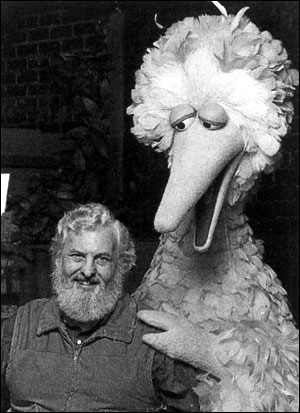
"We set out to make a show that children and adults could watch together, and children could ask questions." -- Jon Stone [1]
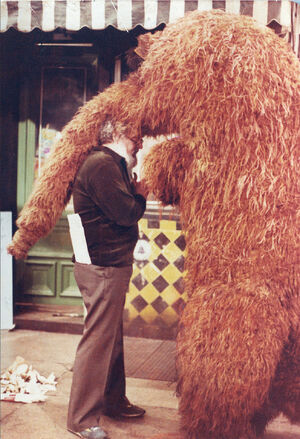
Stone directing Michael Earl as Mr. Snuffleupagus.
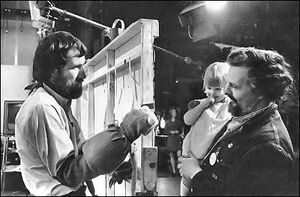
Jim Henson and Jon Stone on set of one of Kermit's lecture sketches.
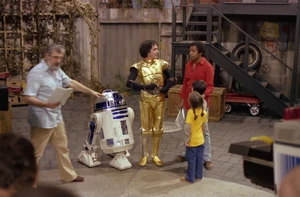
Stone directing Northern Calloway, Anthony Daniels and R2-D2 on the set of Sesame Street.
Jon Stone (April 13, 1931 - March 30, 1997), was an Emmy-winning writer, director, and producer who was involved in the creation of Sesame Street and continued to work on the show until shortly before his death.
Born in New Haven, Connecticut, Stone graduated from Williams College in 1952. He received a master's degree from the Yale University School of Drama in 1955, at which time he joined a CBS training program. Before helping to create Sesame Street, he worked on the popular children's television show Captain Kangaroo for CBS. He also worked on several other Muppet projects before and during his time on Sesame Street, and was the author of several books, including the popular The Monster at the End of This Book. He was married for 9 years to actress Beverly Owen.
Stone's earliest association with Jim Henson came in 1965, working on fairy tale projects, along with writer Tom Whedon, such as a proposed Snow White series. This was turned into a Cinderella pilot, which was shot in October of that year but never aired, and eventually became Hey Cinderella!. Stone also appeared in Henson's 1967 short film Ripples, as an introspective architect.
In 1968, Stone brought Henson and Joe Raposo to the attention of CTW president Joan Ganz Cooney when she started putting together Sesame Street. He wrote the pilot script, and was one of the three original producers of the program; he later served as an executive producer for many years.
During a 1980 trip to Sesame Street's German co-production Sesamstrasse, Stone appeared on the show's 750th episode, together with Big Bird, Oscar the Grouch, Kermit Love and Caroll Spinney's wife Debi Spinney.
In a 1999 article, Children's Television Workshop Director of Research Edward L. Palmer recalled how Stone approached writing for Sesame Street in the early days of the production:
Stone was the show's principal director until 1996. Working with Jim Henson, he helped to create many of the Muppet characters, including Big Bird and Cookie Monster. He was also responsible for the show's format and setting. Stone contributed occasional announcer voices (such as the soap opera promo spoof "School in the Afternoon"), and served similar duty on two Muppet Meeting Films. In April 1990, Stone hosted and directed a television special titled Sing! Sesame Street Remembers Joe Raposo and His Music. The special was created as a tribute to Joe Raposo, who passed away from lymphoma in February 1989.
Jon Stone died of complications from Lou Gehrig's disease on March 30th, 1997. In his New York Times obituary, Joan Ganz Cooney describes Stone as "probably the most brilliant writer of children's television material in America."
Memorial Bench
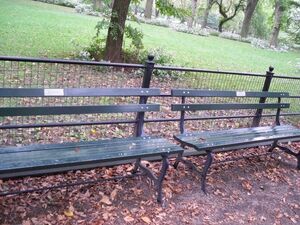
Central Park Benches dedicated to Jim Henson and Jon Stone.

Following Stone's death, a bench on the Literary Walk in Central Park was dedicated to him. The bench is directly to the right of the bench dedicated to Jim Henson.
Credits
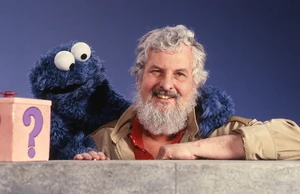
Jon Stone with Cookie Monster, circa 1986.
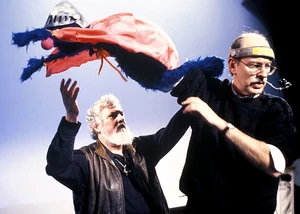
Stone with Frank Oz and Super Grover.
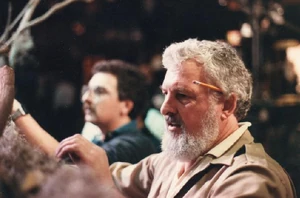
Director:
- Youth 68 (1968)
- Sesame Street, from 1969-96
- Christmas Eve on Sesame Street (1978)
- Don't Eat the Pictures: Sesame Street at the Metropolitan Museum of Art (1983)
- Big Bird in China (1983)
- My Sesame Street Home Video
- Big Bird in Japan (1988)
- Sesame Street, Special (Put Down the Duckie) (1988)
- Monster Hits! (1990)
- Sing Yourself Silly! (1990)
- Elmo's Sing-Along Guessing Game (1991)
- Big Bird's Birthday or Let Me Eat Cake (1991)
- Mr. Willowby's Christmas Tree (1995)
Writer:
- Sesame Street Pitch Reel (1969)
- Hey Cinderella! (1970)
- Julie on Sesame Street (1973)
- The Muppet Show: Sex and Violence (1975)
- Christmas Eve on Sesame Street (1978)
- Sesame Street Live: A Sesame Street Mystery: The Case of the Missing Rara Avis (1980)
- Sesame Street Live: Big Bird's Super Spectacular Totally Amateur Show (1981)
- John Denver & The Muppets' Rocky Mountain Holiday (1982)
- Big Bird in China (1983)
- Big Bird in Japan (1988)
- Sesame Street Live: Big Bird's Sesame Street Story (1988)
Author:
- The Sesame Street Storybook (1971)
- The Monster at the End of This Book (1971)
- Would You Like to Play Hide & Seek in This Book With Lovable, Furry Old Grover? (1976)
- The Sesame Street Library (1978-1979)
- Christmas Eve on Sesame Street (book) (1981)
- The Songs of Sesame Street in Poems and Pictures (1983)
- Lovable Furry Old Grover's Resting Places (1984)
- Another Monster at the End of This Book (1996)
Lyrics:
- "ABC-DEF-GHI"
- "Best Friends"
- "Big Bird's Beautiful Birthday Bash"
- "Danger's No Stranger"
- "Everybody Wash"
- "Get Along"
- "One of These Things"
- "Sesame Street Theme"
- "Wet Paint"
Sources
- ↑ Jon Stone obituary by Lawrence Van Gelder, The New York Times, April 1, 1997.
- ↑ "The Beginnings of Sesame Street Research", Edward L. Palmer with Shalom M. Fisch, chapter 1 of G is for Growing: Thirty Years of Research on Children and Sesame Street, 2001.
